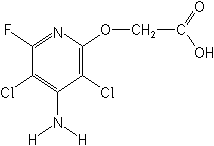-
Common NameFluroxypyr
-
中文通用名氟草烟
-
IUPAC4-amino-3,5-dichloro-6-fluoro-2-pyridyloxyacetic acid
-
CAS[(4-amino-3,5-dichloro-6-fluoro-2-pyridinyl)oxy]acetic acid
-
CAS No.69377-81-7
-
Molecular FormulaC7H5Cl2FN2O3
-
Molecular Structure
-
Category
-
ActivityHerbicide
-
PremixTribenuron-methyl+fluroxypyr
Tribenuron Methyl+Carfentrazone-ethyl+Fluroxypyr-meptyl
Thifensulfuron-methyl+tribenuron-methyl+fluroxypyr
thifensulfuron-methyl + fluroxypyr 1-methylheptyl ester
thiencarbazone+tribenuron+thifensulfuron+fluroxypyr+MCPA
Rimsulfuron+Mesotrione+Fluroxypyr-meptyl
pinoxaden+clodinafop+2,4-D ester+fluroxypyr
Penoxsulam+Fluroxypyr-meptyl
Penoxsulam+Cyhalofop-butyl+Fluroxypyr-meptyl
Nicosulfuron+Fluroxypyr-meptyl+Halosulfuron-methyl
Nicosulfuron+Dicamba+Fluroxypyr
metsulfuron-methyl + thifensulfuron-methyl + fluroxypyr 1-methylheptyl ester
Mesotrione+Atrazine+Fluroxypyr-meptyl
MCPA-sodium+Glyphosate ammonium+Fluroxypyr-meptyl
MCPA+fluroxypyr
Halauxifen-methyl+Fluroxypyr-meptyl
Fluroxypyr-meptyl+thifensulfuron-methyl+ethametsulfuron+tribenuron-methyl
Fluroxypyr-meptyl+Carfentrazone-ethyl+Florasulam
Fluroxypyr+Nicosulfuron+Atrazine
Fluroxypyr+florasulam
Fluroxypyr+clodinafop-propargyl
Fluroxypyr+carfentrazone-ethyl
Fluroxypyr+2,4-D ester
Florasulam+MCPA-isooctyl+fluroxypyr-meptyl
Florasulam+Fluroxypyr-meptyl
florasulam+fluroxypyr+MCPA
fenoxaprop+fluroxypyr+dicamba
Cyhalofop-butyl+Fluroxypyr-meptyl
Cyhalofop-butyl+Clomazone+Fluroxypyr-meptyl
clopyralid+fluroxypyr+pyroxsulam
Clodinafop-propargyl+Carfentrazone-ethyl+Fluroxypyr-meptyl
Bromoxynil octanoate+Nicosulfuron+Fluroxypyr-meptyl
Bensulfuron-methyl+Fluroxypyr-meptyl
Premix Parters: pyrazophos;
-
Physical PropertiesMolecular weight:255.0; Physical form:White, crystalline solid. Density:1.09 (24 °C); Melting point:232-233 °C; Vapour pressure:3.784 ×10-6 mPa (20 °C, Knudsen effusion); Henry constant:1.06 × 10-8 Pa m3 mol-1 ( calc.); Partition coefficient(n-octanol and water):logP = -1.24 (unstated pH); pKa:2.94; Solubility:In water 91 mg/l (unspecified pH, 20 °C). In acetone 51.0, methanol 34.6, ethyl acetate 10.6, isopropanol 9.2, dichloromethane 0.1, toluene 0.8, xylene 0.3 (all in g/l, 20 °C).; Stability:Stable in acidic media. Fluroxypyr is acidic, and reacts with alkalis to form salts. DT50 in water 185 d ( pH 9, 20 °C). Stable at temperatures up to melting point. Stable in visible light.
-
ToxicologyOral:Acute oral LD50 for rats 2405 mg/ kg. Percutaneous:Acute percutaneous LD50 for rabbits >5000 mg/kg. Mild eye irritant; non-irritating to skin (rabbits). Inhalation: LC50 (4 h) for rats >0.296 mg/l air. Phytotoxicity:Non-phytotoxic to the crops for which its use is recommended.
-
Environmental ProfileEcotoxicology:
Algae: EC50 (96 h) for green algae >100 mg/l.Bees:Not toxic to bees. LD50 (contact, 48 h) >25 μg/bee.Birds:Acute oral LD50 for mallard ducks and bobwhite quail >2000 mg/ kg.Daphnia: LC50 (48 h) >100 mg/l.Fish: LC50 (96 h) for rainbow trout and golden orfe >100 mg/l.
Environmental fate:
Animals:In rats, following oral administration, fluroxypyr is not metabolised, but is rapidly excreted unchanged, principally in the urine.Soil:In soil, fluroxypyr is rapidly degraded by micro-organisms in aerobic conditions to 4-amino-3,5-dichloro-6-fluoropyridin-2-ol, 4-amino-3,5-dichloro-6-fluoro-2-methoxypyridine, and CO2. DT50 in laboratory soil studies Plant:In plants, fluroxypyr is not metabolised, but biotransformation to conjugates occurs. -
Transport InformationSignal Word:WARNING; Hazard Class:II(Moderately hazardous)
Porduct NewsMore
ADAMA launches Timeline® FX, to deliver superior control and flexibility over broadleaf weeds
Pinoxaden Florasulam Fluroxypyr
Corteva launches Pixxaro EC herbicide for cereal grains
Nufarm registers herbicide Tibet in Brazil
Corteva's OpenSky herbicide receives US registration
Nufarm launches herbicide Scorch for resistant kochia in U.S.
Dow AgroSciences announces new spring wheat herbicide
Clopyralid Fluroxypyr Pyroxsulam
Adama Canada: new Outshine broadleaf herbicide for cereals
More US registration reviews planned
Cyhalofop-butyl Diclofop-methyl Fluroxypyr Imazapic Noviflumuron Tebufenpyrad Etoxazole Polyoxin d zinc salt
Related CompaniesMore
Country: India
Zinc phosphide Aluminium phosphide Profenofos Glyphosate Tebuconazole Chlorpyrifos Fluroxypyr Chlorpyrifos+cypermethrin Cypermethrin+profenofos Tebuconazole+Sulphur Sulphur
Country: India
Permethrin Imidacloprid Cypermethrin Chlorpyrifos Alpha-cypermethrin Triclopyr Deltamethrin Fluroxypyr Quinalphos Temephos
Jiangsu Fuding Chemical Co., Ltd.
Country: China
Penoxsulam Metamifop Fluroxypyr 2,3-D-Difluoro-5-chloropyridine 2-Amino-6-nitrobenzoic acid
Shanghai Nicex International Trading Co.,Ltd.
Country: China
Oxadiazon Oxadiargyl Azoxystrobin TC Bentazone 2,4-D TC MCPA TC Nicosulfuron Tribenuron-methyl Bispyribac-sodium
Ningxia Lamtin Agricultural Development Co.Ltd.
Country: China

 0
0 Subscribe
Subscribe
